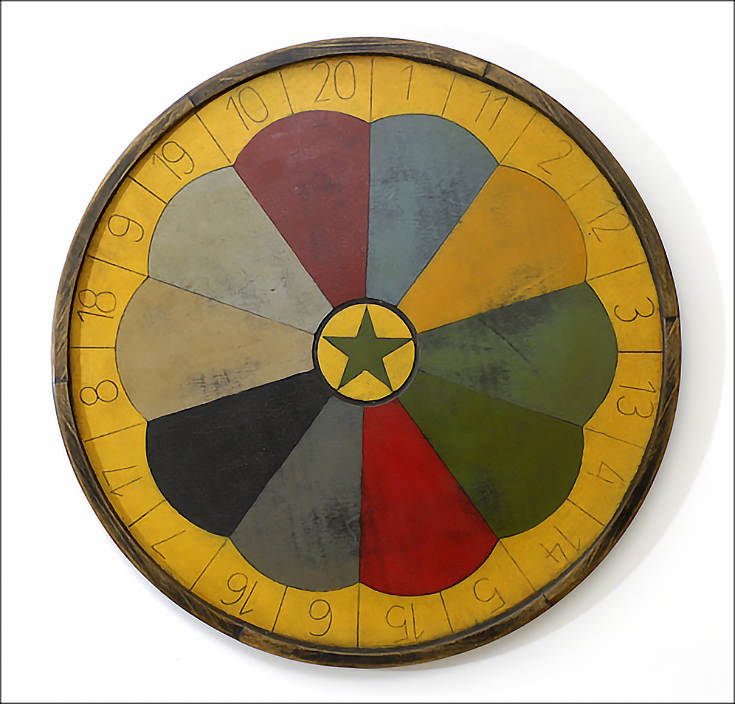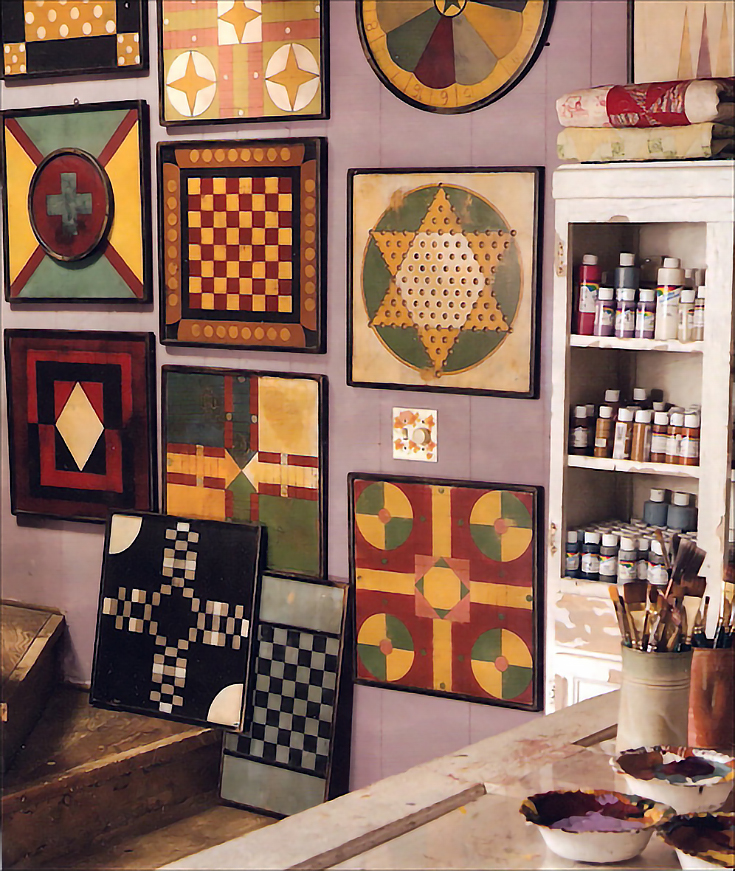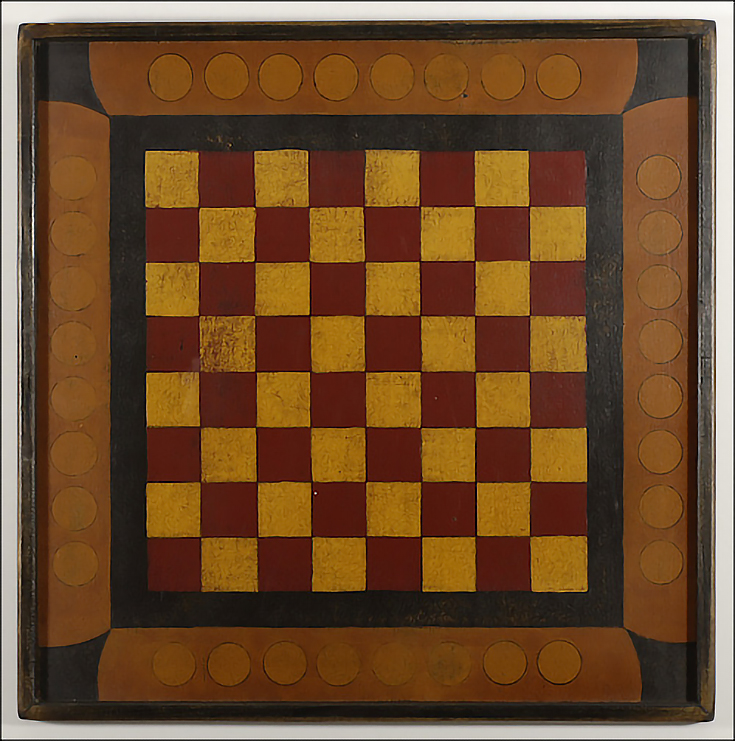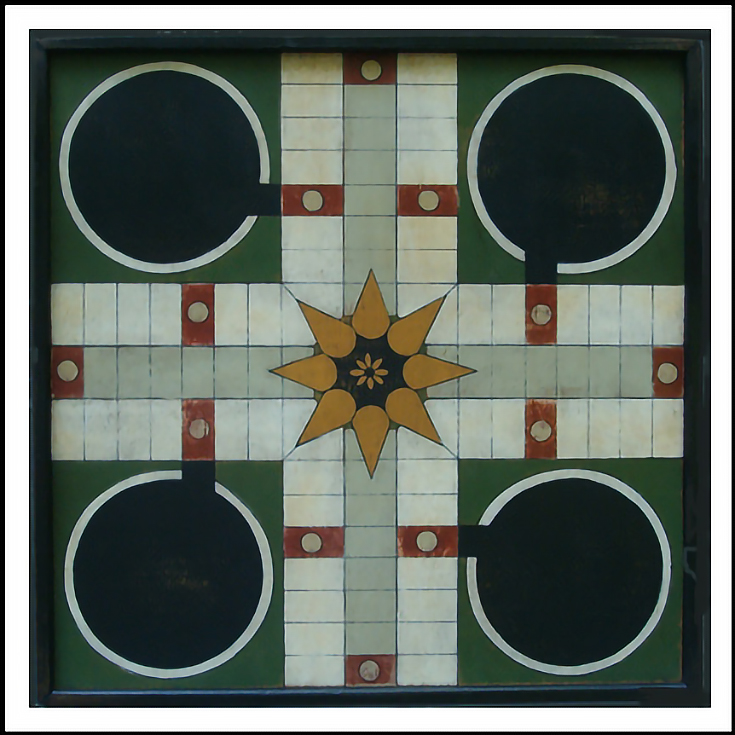
Diane Allison has been creating and selling her custom game boards for eighteen years, and was listed in Country Living Magazine as the 29th Guild Artist. . . a great honor.
While Diane reached success by having her custom game boards sold throughout the world in shops and catalogs, she currently spends her days designing game boards for collectors and individuals.
Alyice: You create hand-painted board games. How did you come up with this idea?
Diane: After recently moving to Dallas Texas I made some wonderful friends that were quilters in my neighborhood. They met once a week for Stitch and Bitch, and I was just dying to join them. I was told I couldn’t join the quilting group until I made a quilt! So at 35 years of age, I began the journey into learning how to sew and create quilts.
It was a wonderful creative gathering of women who shared ideas, food, laughs and encouragement to each other.
I began to notice at this time that my oldest son would come in from school, drop off his backpack and head out to be with his friends. I wasn’t “needed” by him anymore those couple of hours after school so I began thinking of what course my life could start to take.
I picked up a magazine that had many ideas of things I could make and was immediately attracted to game boards; to me they were miniature quilts on wood, very geometric and colorful.
I hadn’t painted anything before other than rooms in my home but I headed off to the craft store gathering paints and brushes, and over to the home wood store to pick-up wood, nails and a small saw. I made a few game boards to decorate my home. My quilt friends loved them so I thought I could possibly sell them.
I started going door-to-door to shops in Dallas and was welcomed with open arms. If a store didn’t feel my game boards worked with their current style they recommended other places for me to try.
I didn’t take a “no” personally because I knew that I needed to find the right niche.
Alyice: How does creating art make you feel?
Diane: I love the days when I can work on new designs. . . the studio turns to true chaos, paints are everywhere, wood is everywhere. . . and I am creating. . . starting with nothing in the beginning and then seeing the final colors in design. The chaos, however, is a welcomed chaos because those are the days I enjoy the most.
Alyice: Some of the game boards you design are reproductions of early games, i.e. circa 1900. How do you go about making sure your replicas are exact?
Diane: Almost all of my pieces are reproductions, but with a twist.
They will not fall into a “true reproduction” category because my woods are different, my paints are different and my finishing is different so really they are “inspired on” or “based on” an old piece.
I try to keep the dates back in the 1800’s though, but there were some great pieces from the early 1900’s that I have found and had to try my hand at. There are books out there that have the history of so many game boards: where they were located, photos, information about the piece, etc.
When I first started though, the books were not available for sale, so I went to the library and actually used microfilm to find old information on pieces.
Alyice: Aside from having a nostalgic feel, your game boards look like abstract art. What do you do to preserve the quality of the art, while still allowing your buyers to actually use the game boards?
Diane: I would say 99% of my clients use them only to hang as wall art, or to prop here and there for a splash of color. The other 1% use them—it won’t hurt them—you just dust with a dry smooth cloth.
Alyice: You use Baltic Birch wood, which is brought back from Russia, to create your game boards. Can you tell us why you chose this particular type of wood and how it affects your work?
Diane: I chose Baltic Birch because I love the weight and feel of it. It is mostly used for very nice cupboards in homes. The sheets are smaller than others and it’s a lot pricier, but once I saw it, I had to use it.
I actually loved the idea that it came from Russia. . . so far from us, and our country has such a history with Russia. So I guess it’s kind of my political view too; leave it to the people of different countries to work together and make things happen and they will.
On each of my game boards I sign it with my hand-print and my signature, and when I do this, it reminds me of how many hands it actually did take to bring this piece to the person who will have it. . . many hands in Russia, on ships, to my lumber yard. . . that is a lot of connections going on.
Alyice: Sometimes you give old board games an entirely new design, while staying true to the actual layout of the original game, can you share the inspiration behind these pieces?
Diane: I think you might be thinking of my line of “Gee’s Bend” inspired pieces. These game boards are based on actual quilt designs and then I turn the layout into an actual game.
It’s a pretty time consuming and difficult process but there is something about the history of the “gee’s bend” quilters and the colors that they used that I just can’t walk away from.
COLOR is what these pieces are all about.
It is the time when I can really work with colors that I don’t normally work with; my colors are pretty deep and warm and moody. Gee’s Bend is anything but. They are full of life. . . in all of its shades. As far as “how to”. . . I simply just decide on a quilt, usually by its colors, draw it up and ta da!

Alyice: How long did it take you to start earning a regular income from your art, after that first sale?
Diane: I’ve never had a “regular” income. I don’t think that is possible. When I began I sold wholesale to stores only. I could, after years, kind of guesstimate what I would make in an upcoming year. But it is never regular, so if you HAVE to have a certain amount of income a month or you can’t make it, you really have to do art on the side.
I think I was really an exception to the rule for I was only in business for a month before a New York Manufacturer called me to ask if I would like to put my game boards in her show rooms in Atlanta and New York (she really just thought they were so pretty and went well with her line and was certainly doing me a HUGE favor, and I felt honored).
Also, within just a few months I landed my first catalog job. So really looking back I flew to the top in sales within the first year and was already sending pieces to European stores.
But here is why: I worked my butt off! And all before the days before Google and computers.
I typed one letter introducing myself to what I was hoping were future stores that would want my wares, and attached a close-up photo of a piece, then I made copies of the letter and photos. It actually, and I will never forget, cost $25.00 to open my business.
I then went through all the Country Living magazines that I could find where they had store listings, and sent them my introduction letter. The phone rang, and rang! Now that was when the fear of going too fast began to set in. But I learned to deal with that as I went along.
Alyice: I understand that you have several stores selling your hand painted game boards, can you tell us what this is like?
Diane: If a store didn’t feel my work fitted with their current style they would recommend other places for me to try. I didn’t take a “no” personally. You can’t take it to heart. THEY REALLY DO KNOW what they can sell.
I currently sell only to my first store account in Texas. I moved to North Carolina from Texas 15 years ago. Over the years we have become friends and I wouldn’t say no to her for the world, she was my first!
About 3 years ago I decided that I really couldn’t have a family life and have a wholesale business and a retail business so I decided to quit selling wholesale period. It is very time consuming because stores would sometimes order 20 pieces at a time.
I had employees and it really felt like I was in the manufacturing business instead of the art business so I made that choice to quit wholesale. It was scary, for that was income that I counted on to come in yearly, but sometimes you just have to jump off that cliff and see what happens.
So now I am selling directly to retail clients only.
It’s nice to see that most of my clients are collectors and come back to order another piece. It does make you feel good when they send you a photo and show you a wall of your pieces. I love them!
Alyice: Was there anything you wish you would’ve know before you started to selling your game boards in shops?
Diane: Really there isn’t. You just have to play it by ear.
If you have holiday-themed items you might want to approach shops 3 to 6 months in advance because there is a good chance that in July they are ordering Christmas items.
I would be leery of consignment. The store has nothing to lose and you can sometimes be decorating their shop at your expense. I do not do consignment unless it’s to our local co-op gallery. If you do choose to do consignment , consider a contract of some sort letting them know that you will have the piece in their store for only three months. If it doesn’t sell, you’re pulling it.
Alyice: Aside from the shops, do you do any promoting offline?
Diane: No. Pretty much new clients find me through searching the ‘net. I do not do art shows either, so it’s really repeat business, word of mouth, and Internet searches.
To learn more about Diane Allison’s custom game boards, please visit her website at dallison.squarespace.com or her blog at dianeallisonblog.blogspot.com.
This post may contain affiliate links.



